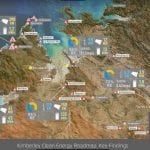Around The Web
Enel advances hedging over Q3 as sales inch higher
India pegs Mar. 2019 as potential start date for pilot carbon market mechanism
ExoMars: Where to send Europe's robot rover?
South Korea curbs fossil fuel output to battle pollution
INTERVIEW: NZ minister wants focus on domestic emission cuts, not international credits
Urban mountains: Shenzhen's green rooftop project – in pictures
The Chinese megacity of 12 million people is crowded, polluted, and vulnerable to flooding. A rooftop garden is using plants to make stormwater work for the city, and to improve the livelihoods of residents
Continue reading...Angus Taylor attempts to secure power price reductions
Will the arrival of El Niño mean fewer mosquitoes this summer?
CP Daily: Tuesday November 6, 2018
California elects Brown’s successor, Democrats on track to flip Maine governor
Washington state CO2 tax likely to fail in preliminary results
Taylor confirms race is on to get new coal or gas finalised before federal election
 Energy minister Angus Taylor wants to get new investment in coal and gas locked away before the next election.
Energy minister Angus Taylor wants to get new investment in coal and gas locked away before the next election.
The post Taylor confirms race is on to get new coal or gas finalised before federal election appeared first on RenewEconomy.
Plan to shift Kimberley to renewables could save $15m a year
 Kimberley Clean Energy Roadmap reveals 60-90% mix of solar, battery storage and wind power can out-compete diesel or fracked gas on cost across the region.
Kimberley Clean Energy Roadmap reveals 60-90% mix of solar, battery storage and wind power can out-compete diesel or fracked gas on cost across the region.
The post Plan to shift Kimberley to renewables could save $15m a year appeared first on RenewEconomy.
JA Solar further promotes new energy development in Australia
 JA Solar has supplied all solar modules to South Australian Water Corporation ("SA Water") for its 4.14MW coastal photovoltaic project.
JA Solar has supplied all solar modules to South Australian Water Corporation ("SA Water") for its 4.14MW coastal photovoltaic project.
The post JA Solar further promotes new energy development in Australia appeared first on RenewEconomy.
Solar photovoltaics and wind energy: the climate change solution
 Solar PV and wind energy are growing fast enough to eliminate global coal, oil and gas consumption before 2050 - if politics allows.
Solar PV and wind energy are growing fast enough to eliminate global coal, oil and gas consumption before 2050 - if politics allows.
The post Solar photovoltaics and wind energy: the climate change solution appeared first on RenewEconomy.
Storage to become $1.7 trillion market, super-charged by networks and consumers
 BloombergNEF says networks and consumers set to drive global energy storage boom worth $A1.7 trillion, as cost of batteries tumbles by 52%.
BloombergNEF says networks and consumers set to drive global energy storage boom worth $A1.7 trillion, as cost of batteries tumbles by 52%.
The post Storage to become $1.7 trillion market, super-charged by networks and consumers appeared first on RenewEconomy.
TVA shifts from coal with 377 MW solar pipeline for Facebook
 Tennessee Valley Authority, not a great fan of non-hydro renewables, signs deal two big solar developments that will deliver 100% renewable energy to local Facebook data centres.
Tennessee Valley Authority, not a great fan of non-hydro renewables, signs deal two big solar developments that will deliver 100% renewable energy to local Facebook data centres.
The post TVA shifts from coal with 377 MW solar pipeline for Facebook appeared first on RenewEconomy.
Dubai expands mega solar project at “record” low price
 Dubia expends the scale of its mega solar park, and does so at a world-record low price for solar.
Dubia expends the scale of its mega solar park, and does so at a world-record low price for solar.
The post Dubai expands mega solar project at “record” low price appeared first on RenewEconomy.
Northern white rhino: New hopes for IVF rescue
Man uses surfboard to fight off shark at Ballina on NSW north coast
Surfer, 43, in hospital after attack at Shelly beach near Ballina on Wednesday morning
A man has used his surfboard to fend off a shark after being attacked in waters off Ballina on the New South Wales north coast.
The 43-year-old was bitten on his calf at Shelly beach about 7am on Wednesday and is being treated at Lismore hospital, NSW police said.
Continue reading...


